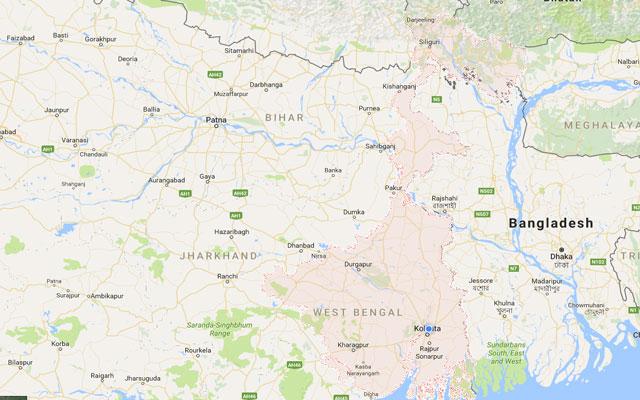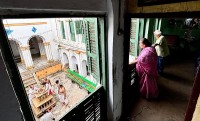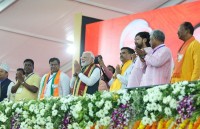 image
image
Industrialization Growth and Way Forward for West Bengal
Kolkata, Jan 19 (IBNS): Statistics reveals that the rate of industrial power consumption in WBSEDCL area during last few years has been decreasing rapidly.
There may be a lot of reasons behind it. One of the major reasons is high tariff determined by the West Bengal Electricity Regulatory Commission which appears to operate favoring the Generating Companies in West Bengal as well as Distribution Licensees, operating in West Bengal.
Five Distribution Licensees viz WBSEDCL, CESC, DVC, DPL and DPSC/India Power Company Ltd supply Power to different categories of consumers. Of it only WBSEDCL supplies power to all categories of consumers in different geographical area in West Bengal staring from coastal Bengal to Hill through Rural belt, Cities and Towns in West Bengal. DVC, and DPSC/ IPCL are serving only Industrial Consumers in highly concentrated geographical area with a distribution of a highly skewed orientation of industrial consumer base.
Vinay Dalmia, Vice-President, Indian Engineering Industry mentioned that this leads to a natural injustice to the consumers, particularly, industrial consumers belonging to WBSEDCL who have to share the burden of Cross Subsidy Surcharges to keep the tariff of some particular categories of consumers low in WBSEDCL area.
He further mentioned that while any Distribution Licensees should have universal obligation to supply all consumers of different categories, the same has been violated by DVC and at the same time deliberately overlooked by WBERC. So far no action, permitted by Electricity Act,2003 has yet been taken by WBERC, favoring to have low tariff by the consumers of DVC who has not built the necessary infrastructure to fulfil its universal obligation, leaving the responsibilities to serve all categories of consumers solely on WBSEDCL.
WBSEDCL have a consumer base more than 1.6 crore, around 83% of total consumers in West Bengal, out of which major low profile consumer are in rural and coastal Bengal, hill and jungles who needs the support of Cross Subsidy from high profile industrial and commercial consumers. The commercial consumers have to compete within a limited geographical areas but Industries have to compete within the country even globally.
Dalmia mentioned that there is no doubt that power intensive industry like iron & steel is suffering badly due high tariff in WBSEDCL area and are in the dying stage. A good number of industry in West Bengal are closed. Only skeleton of the factory premises are existing showing the true image of West Bengal industrial environment. A lot of representation was made to the different corner, including Govt. of West Bengal. No respite from any influential corner has yet been observed.
Dalmia mentioned that another reason for high tariff of WBSEDCL industrial consumers is due to high aggregated technical and commercial loss (ATC) loss which is not been controlled by the authority. The inefficiency of WBSEDCL has cost the industrial consumers starving for reasonable power tariff. Govt. Of West Bengal has been till now been indifferent to this. The closure of a large number of industries and dearth of investment in industrial sector has made WBSEDCL, potentially weak and this leads them to think to develop a competitive tariff in a particular geographical area ie. a multiple licensee area in West Bengal.
However a small number of industrial consumers have been benefited due to implementation of a new competitive tariff in that particular multiple licensee area. Realizing the sentiment and difficulties of the rest of the industrial consumers, WBSEDCL has come up with a energy cost relief scheme which will entail it to have more business in this particular area. However WBERC appears to be reluctant to give clearance to go ahead. Proposal was submitted by WBSEDCL on 30th Nov, 2016. Till date no action from WBERC is observed.
In the power Market, electricity is, at present, available at low price, as low as around 244 paisa/ kwh (on an average). As a matter of survival, some of the industrial consumers opted for procurement of power from the market. The main obstacles are high cross subsidy charge and wheeling charge and attitude to accord NOC by WBSEDCL.
The Tariff in West Bengal, as well as Cross Subsidy Charge (at present around 290 p/kwh) has been set by WBERC. This resulted in unviable net per unit cost of import of power under open access mode. So far now the only avail course of remedial action is to procure power under group captive mode which is successful in the state of Maharastra, Guajrat etc. It is apprehended that controlling authorities will not allow open access in a fair way, depriving natural justice. Tariff determined by WBERC is highest in the country, Similar is the situation for Cross Subsidy Surcharge (CSS). Most of other state regulators have kept CSS at a level less than 150 p/kwh.
WBSEDCL, by virtue of a lot of Power Purchase Agreement have surplus energy available. Because of poor market condition, price out of export of power is not remunerative and a lot of generating capacity remain underutilized for which fixed cost has to borne by WBSEDCL without any energy for sale.
Moreover due to technical reason a minimum generation has to be made available by the generators which WBSEDCL has to make a distress sale in the market which, however may be avoided through incentivisation to the industrial consumers through consumption of more power at some lower tariff in line with the tariff offered to Bangladesh by WBSEDCL and the licensee may have a marginal profit out of this scheme vis-a-vis survival of industry in West Bengal. In a consequential effect there may be a surge in demand of power by the industrial consumer as well as industrial growth.
Source: Indian Engineering Industry
WBSEDCL have a consumer base more than 1.6 crore, around 83% of total consumers in West Bengal, out of which major low profile consumer are in rural and coastal Bengal, hill and jungles who needs the support of Cross Subsidy from high profile industrial and commercial consumers. The commercial consumers have to compete within a limited geographical areas but Industries have to compete within the country even globally.
Dalmia mentioned that there is no doubt that power intensive industry like iron & steel is suffering badly due high tariff in WBSEDCL area and are in the dying stage. A good number of industry in West Bengal are closed. Only skeleton of the factory premises are existing showing the true image of West Bengal industrial environment. A lot of representation was made to the different corner, including Govt. of West Bengal. No respite from any influential corner has yet been observed.
Dalmia mentioned that another reason for high tariff of WBSEDCL industrial consumers is due to high aggregated technical and commercial loss (ATC) loss which is not been controlled by the authority. The inefficiency of WBSEDCL has cost the industrial consumers starving for reasonable power tariff. Govt. Of West Bengal has been till now been indifferent to this. The closure of a large number of industries and dearth of investment in industrial sector has made WBSEDCL, potentially weak and this leads them to think to develop a competitive tariff in a particular geographical area ie. a multiple licensee area in West Bengal.
However a small number of industrial consumers have been benefited due to implementation of a new competitive tariff in that particular multiple licensee area. Realizing the sentiment and difficulties of the rest of the industrial consumers, WBSEDCL has come up with a energy cost relief scheme which will entail it to have more business in this particular area. However WBERC appears to be reluctant to give clearance to go ahead. Proposal was submitted by WBSEDCL on 30th Nov, 2016. Till date no action from WBERC is observed.
In the power Market, electricity is, at present, available at low price, as low as around 244 paisa/ kwh (on an average). As a matter of survival, some of the industrial consumers opted for procurement of power from the market. The main obstacles are high cross subsidy charge and wheeling charge and attitude to accord NOC by WBSEDCL.
The Tariff in West Bengal, as well as Cross Subsidy Charge (at present around 290 p/kwh) has been set by WBERC. This resulted in unviable net per unit cost of import of power under open access mode. So far now the only avail course of remedial action is to procure power under group captive mode which is successful in the state of Maharastra, Guajrat etc. It is apprehended that controlling authorities will not allow open access in a fair way, depriving natural justice. Tariff determined by WBERC is highest in the country, Similar is the situation for Cross Subsidy Surcharge (CSS). Most of other state regulators have kept CSS at a level less than 150 p/kwh.
WBSEDCL, by virtue of a lot of Power Purchase Agreement have surplus energy available. Because of poor market condition, price out of export of power is not remunerative and a lot of generating capacity remain underutilized for which fixed cost has to borne by WBSEDCL without any energy for sale.
Moreover due to technical reason a minimum generation has to be made available by the generators which WBSEDCL has to make a distress sale in the market which, however may be avoided through incentivisation to the industrial consumers through consumption of more power at some lower tariff in line with the tariff offered to Bangladesh by WBSEDCL and the licensee may have a marginal profit out of this scheme vis-a-vis survival of industry in West Bengal. In a consequential effect there may be a surge in demand of power by the industrial consumer as well as industrial growth.
Source: Indian Engineering Industry
Top Headlines
-
News
Sona Incubations, Salem picks 17 startups for Rs 11 Mn DST investment, grant
December 30, 2025
-
News
Visva-Bharati University unveils a transformational roadmap under Vice-Chancellor Dr. Probir Kumar Ghosh
December 29, 2025
-
News
Reject Macaulayan education, reclaim Indian values: H M Bangurs big World Hindu Economic Forum pitch
December 21, 2025
-
News
Horror in Bangladesh: Hindu man lynched and set on fire amid violent protests
December 19, 2025
-
News
Buried at home: UP man arrested for killing wife, two daughters over burqa dispute
December 18, 2025
-
News
Sona College of Technology: Many academic, research and industry-linked advances in 2025
December 17, 2025
-
News
Kolkata: ICCR hosts 10th anniversary celebration of Robir Kiran
December 14, 2025
-
News
Sydney's Bondi Beach horror: Pakistani-origin man named as one of thekeysuspects
December 14, 2025
-
News
Abba Aur Main: Ek Anokhi Dastan Urdu Translation of Neelima Dalmias Memoir Launched at New Delhis Jashn-e-Rekhta Festival
December 14, 2025
-
News
Jaipur: Cultural activist Sundeep Bhutoria calls for Social Investment Policy for Non-resident Rajasthanis at Pravasi Rajasthan Divas
December 14, 2025





